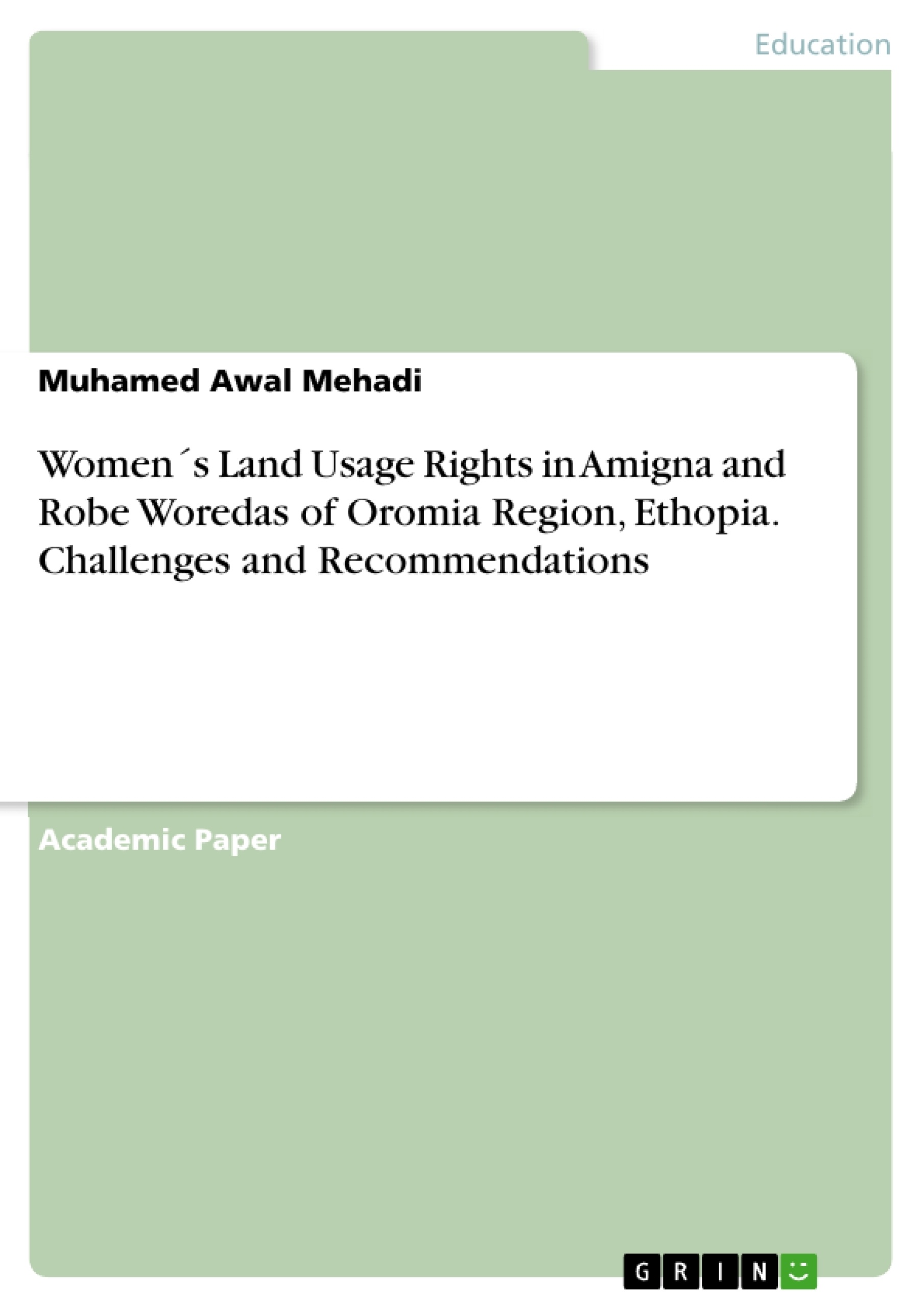The study is configured to explore how women’s in Amigna and Robe woredas of Arsi zone of Oromia national regional state are using their rights in terms of land use rights in the area.
The Oromia National Regional State Rural Land Administration and Use Proclamation and its implementation procedure are examined from a gender perspective in terms of ensuring rural women’s landholding rights. This study forwards the recommendation to address gender gaps identified to ensure women’s equal access to and control over land in the study area.
The study is organized into four Chapters. The first chapter deals with research methodologies, statement of the problem, objective of the study, significance of the study, Limitation of the study, scope of the study and the literature review. The second chapter discusses the general background information regarding women's land use rights more broadly. The third chapter focuses on the challenges hindering women not to practice their land-use rights properly in both Amigna and the Robe districts of East Arsi zone. Finally, Conclusions, Recommendations, and References were are drwan in a last chapter.
Inhaltsverzeichnis (Table of Contents)
- CHAPTER ONE: INTRODUCTION
- 1.1 BACKGROUND
- 1.2 LITERATURE REVIEW
- 1.3 STATEMENT OF THE PROBLEM
- 1.4 RESEARCH QUESTIONS
- 1.5 OBJECTIVES OF THE STUDY
- 1.6 GENERAL OBJECTIVE
- 1.6.1 Specific objectives
- 1.7 METHODOLOGY OF THE STUDY
- 1.8 SIGNIFICANCE OF THE STUDY
- 1.9 DELIMITATION OF THE STUDY
- CHAPTER TWO: GEOGRAPHICAL AND HISTORICAL BACKGROUND OF ROBE AND AMIGNA WOREDAS
- 2.1 GEOGRAPHICAL BACKGROUND OF THE STUDY AREA
- 2.1.1 Background of the study area
- 2.2 LAND, PROPERTY, RESOURCES AND LAND RELATED MATTERS
- 2.2.1 Access to land and other resources:
- 2.2.2. Control over land and other resources:
- 2.2.3 Decision-making
- 2.2.4 Land rights
- 2.2.5 Land rights registration
- 2.2.6 Tenure system
- CHAPTER THREE CHALLENGES FOR THE IMPLEMENTATIONS OF WOMEN'S RIGHTS IN THE DISTRICTS
- 3.1 GENDER INEQUALITY
- 3.2 INADEQUATE HUMAN, TECHNICAL AND FINANCIAL SUPPORTS
- 3.3 WEAK COORDINATION MECHANISMS AT ROBE AND AMIGNA WOREDAS
- 3.3 LIMITED ATTENTION TO NEGLECTED GROUPS AND ISSUES
- 3.4 WOMEN'S DEMAND FOR SERVICES IS LOW
Zielsetzung und Themenschwerpunkte (Objectives and Key Themes)
This research aims to investigate the challenges faced by women in accessing and utilizing their land use rights in Amigna and Robe woredas of the Oromia region. The study examines the implementation of the Oromia National Regional State Rural Land Administration and Use Proclamation from a gender perspective, specifically focusing on ensuring women's landholding rights. The research seeks to identify gender gaps and provide recommendations to ensure women's equal access to and control over land in the study area.- Women's land use rights in Ethiopia
- Gender inequality in land ownership and control
- Implementation of land administration and use policies
- Challenges to women's land rights in Amigna and Robe woredas
- Recommendations for promoting gender equality in land access
Zusammenfassung der Kapitel (Chapter Summaries)
Chapter One: Introduction
This chapter sets the stage for the research by providing background information on the challenges women face in accessing and controlling land in Ethiopia, particularly in the Arsi zone of the Oromia region. It highlights the prevalence of discriminatory practices and cultural norms that limit women's land rights. The chapter also discusses the significance of the study and its objectives, as well as the research methodology used.Chapter Two: Geographical and Historical Background of Robe and Amigna Woredas
This chapter focuses on the geographical and historical context of the study area, providing insights into the land tenure systems and resource access in the region. It explores the specific challenges women face in Amigna and Robe woredas in relation to land ownership, control, and decision-making processes.Chapter Three: Challenges for the Implementations of Women's Rights in the Districts
This chapter delves into the specific challenges hindering the implementation of women's land rights in the study area. It examines the impact of gender inequality, inadequate support systems, weak coordination mechanisms, and limited attention to neglected groups and issues on women's access to and control over land.Schlüsselwörter (Keywords)
This study focuses on women's land use rights, gender inequality, land administration, land tenure systems, rural development, gender-responsive policies, and the Oromia National Regional State Rural Land Administration and Use Proclamation. The research investigates the challenges faced by women in accessing and controlling land in Ethiopia, particularly in the Amigna and Robe woredas of the Arsi zone, and provides recommendations for promoting gender equality in land ownership and management.- Quote paper
- Muhamed Awal Mehadi (Author), 2016, Women´s Land Usage Rights in Amigna and Robe Woredas of Oromia Region, Ethopia. Challenges and Recommendations, Munich, GRIN Verlag, https://www.grin.com/document/507247




